The Brazilian black tarantula is a thick, hairy spider native to the grasslands of Brazil and Uruguay.
It’s easy to care for Brazilian black tarantulas because these spiders are docile and friendly. Brazilian black tarantulas don’t show aggression or hostility, making them good pets for people who want to handle their spiders.
Brazilian Black Tarantula Overview
| Common Name: | Brazilian black tarantula |
| Scientific Name: | Grammostola pulchra |
| Natural Habitat: | Grasslands in Brazil and Uruguay |
| Adult Size: | Up to 8 inches |
| Average Lifespan: | Up to 20 years (females); up to 8 years (males) |
| Diet: | Carnivore |
| Housing: | 12 by 10-inch enclosure, 65 to 85 °F, 55 to 65% humidity |
| Experience level: | Beginner |
Origin
The Brazilian black tarantula (Grammostola pulchra) is found in Brazil and northern Uruguay.
The natural habitat of the Brazilian black tarantula is grasslands. Brazilian black tarantulas like to burrow underground, and these spiders can be found blending in against dark logs or hiding beneath rocks and vegetation. The Brazilian black tarantula’s burrowing allows the spider to hide from predators and ambush its prey.
Appearance and Behavior
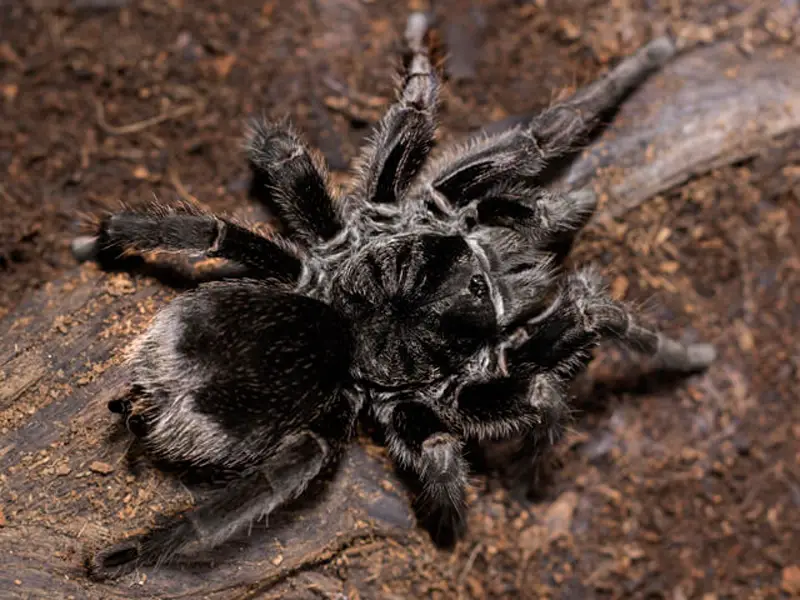
Brazilian black tarantulas have black, wooly, glossy bodies, with thick legs and clustered eyes on the front of their faces.
Certain lighting can make a Brazilian black tarantula appear to have gray or white tones because of the light reflecting off of their hairs. Brazilian black tarantulas are solid black in color, without other colors or patterns.
At first glance, male and female Brazilian black tarantulas look the same. These spiders are the same size, but males have a hook behind one of their front legs, which protects the spiders from the females’ fangs during mating.
Size and Lifespan
Male and female Brazilian black tarantulas span up to 8 inches when fully grown. This species’ maximum leg span is 5–6 inches.
The average lifespan of a male Brazilian black tarantula is 6–8 years. Females live longer than males, with a lifespan of up to 20 years.
Temperament
Brazilian black tarantulas are calm and docile. These spiders are slow movers and very rarely show signs of aggression. This makes Brazilian black tarantulas good pets for handling.
Although rare, a Brazilian black tarantula will defend itself by flicking the urticating hairs off its body. This spider is venomous, but the venom isn’t potent.
You shouldn’t house two Brazilian black tarantulas together. These spiders are cannibalistic and are likely to eat one another if they’re housed together in the same small enclosure.
Housing Brazilian Black Tarantulas
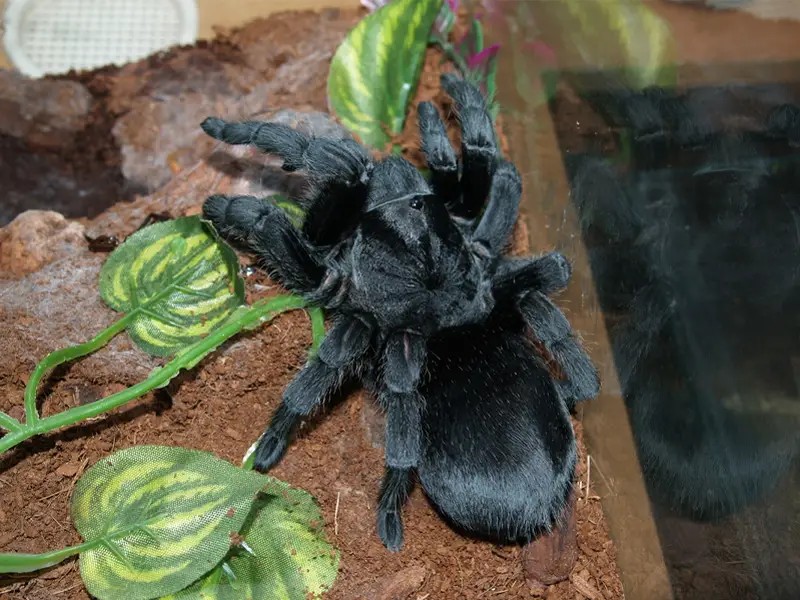
Brazilian black tarantulas are used to vast grasslands with plenty of shade and opportunity for burrowing. You should aim to recreate this environment in your spider’s tank when housing the spider in captivity.
Aquariums, plastic enclosures, and terrariums are all suitable enclosures for housing a Brazilian black tarantula.
Enclosure Size
A fully-grown Brazilian black tarantula requires a 12 by 10-inch enclosure. These spiders are burrowers, and a tank with extra height will allow you to place a thick layer of substrate inside the tank for your spider to dig into. However, you should only buy a tall enclosure if you can provide a good amount of substrate. If the tank is tall and the substrate doesn’t create enough height, your spider is at risk of falls that could result in injury or death.
The ideal width of the enclosure should be up to three times the tarantula’s leg span. Brazilian black tarantulas are terrestrial and enjoy exploring land, so the more width you can provide in their tank, the better.
Lighting
Because Brazilian black tarantulas are used to burrowing and spending most of their time in the shade in the wild, lighting isn’t an important feature in their enclosure. If you house your spider in a room with a window, the spider will get enough light from natural sunlight.
Brazilian black tarantulas don’t need to bask, but some spiders enjoy basking. Installing a 15-watt fluorescent light near the spider’s enclosure is optional, and the light will provide an area for your spider to bask.
Temperature and Humidity
In the wild, Brazilian black tarantulas are used to temperatures of between 65 and 85°F. You should provide the same temperature range in your enclosure to keep your spider comfortable.
If your home’s temperature is room temperature (68°F), you won’t need to use additional heating in the tank. However, if your temperature falls below 68°F, a heating pad placed under one side of the tank will be necessary.
A heating pad can give your tank a temperature gradient, allowing your spider to choose between the warm side and the cool side of the tank. This should help your Brazilian black tarantula regulate its body temperature.
You can use a thermometer to keep track of the enclosure’s temperature if you want to make sure that the tank isn’t too hot or too cold.
To maintain humidity in the tank, add a shallow dish containing fresh water to the enclosure. Brazilian black tarantulas need a humidity of 55% to 65%. If humidity is higher than this, the spider could become dehydrated. A thermometer can be used to monitor humidity.
Brazilian black tarantulas require less humidity than other tarantulas. You don’t need to mist adult black tarantulas with a leg span longer than one inch. However, spiderlings with leg spans shorter than one inch require light misting and a moist substrate.
Providing enough ventilation in your tarantula’s enclosure is essential. Make holes in the side of the enclosure to allow for cross ventilation, rather than only ventilating the tank from the top.
Substrate and Decoration
Because Brazilian black tarantulas are burrowers, these spiders require at least four inches of substrate in the enclosure. Ground coconut fiber and chemical-free potting soil are the best materials to use as substrate in your tank because these materials are light and fluffy, and they absorb the right amount of moisture. You should pack the substrate tightly to allow for easy burrowing.
Don’t buy substrate with sticks or jagged pieces that could damage your tarantula’s delicate body. Avoid substrates that have been treated with additives or fertilizers because this could make your spider sick. You should avoid aquarium gravel because it holds onto too much water and could trap your tarantula.
Brazilian black tarantulas are used to having plenty of hiding places in the wild. Artificial plants, a plant pot laid on its side, and curved pieces of cork or wood bark can give your tarantula a sheltered spot in the tank.
Most Brazilian black tarantulas will sleep in their own burrows, so as long as you have enough substrate, you don’t need to make a designated bedding area in the tank.
Cleaning
To reduce your spider’s risk of illness and prevent bad smells, you should clean the tank regularly.
Brazilian black tarantulas aren’t messy creatures. However, you should still spot clean the enclosure at least once a week and remove any waste or leftover food that you can find.
Conduct a deep clean of the enclosure every four months. Deep cleaning involves removing the substrate and decorations and washing the tank out. Replace the substrate with fresh material and clean each decoration with dish soap and water before returning the decorations to the tank.
During spot cleans, it isn’t essential to remove your spider from the tank. Brazilian black tarantulas are slow movers, and your spider shouldn’t try to escape when you open the hatch.
For deep cleaning jobs, you should put your spider in a separate, secure tank while you clean out the everyday tank. Add familiar decorations to the temporary tank to make your spider feel more at ease.
Warm water should work well to clean the tank and decorations. For stubborn stains, use a small amount of dish soap. Never use bleach or chemical cleaners in your spider’s tank because the fumes will kill your spider.
Brazilian Black Tarantula Care
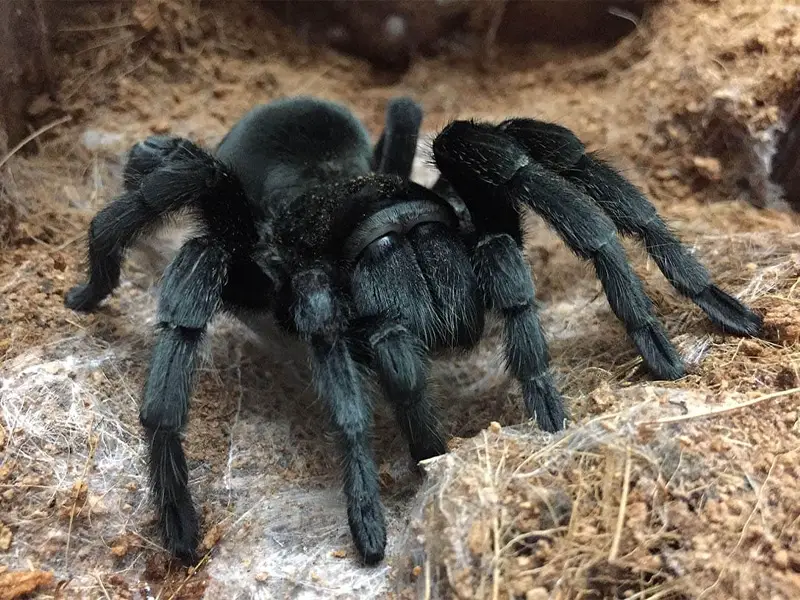
Brazilian black tarantulas are easygoing, and these spiders don’t have many care requirements. Brazilian black tarantulas make good pets for beginner spider keepers and children.
Food and Water
A proper, balanced diet will help your Brazilian black tarantula thrive in captivity. As enthusiastic eaters, Brazilian black tarantulas will capture and eat any prey that the spiders can overpower.
You should feed young tarantulas a diet of smaller foods, such as small mealworms, pinhead crickets, and fruit flies.
Feed your adult Brazilian black tarantula a combination of captive-bred dubia roaches, locusts, moths, grasshoppers, mealworms, and live crickets. Small lizards and pinky mice are foods to offer your tarantula as occasional treats.
Don’t feed your tarantula insects you have found outside because this can introduce parasites to your tank and potentially kill your spider. You shouldn’t include crickets in your tarantula’s diet because these live insects will irritate the spider.
Juvenile Brazilian black tarantulas need to eat one or two small insects every couple of days. Mature tarantulas should eat a single large insect, or several small-sized insects, twice per week.
A shallow water bowl is the best source of water for the Brazilian black tarantula species. Unfiltered tap water is fine for your spider to drink. Replenish the bowl with fresh water every day.
Handling
Brazilian black tarantulas have a docile nature, and these spiders can be handled with care. You should calmly handle your spider to prevent the spider from getting startled.
To safely handle your pet tarantula, follow these steps:
- Assess your spider and determine whether now is a good time for handling. Avoid handling your spider after feeding if your spider looks stressed or if your spider is molting.
- Take hold of your spider using your thumb and forefinger, gripping the spider’s body between the second and third pair of legs. Don’t grip too tightly because spiders are delicate, and this could damage your tarantula’s body.
- Place your tarantula onto your palm. Brazilian black tarantulas are slow movers, and your spider probably won’t move at all once on your palm. Don’t prod your spider or make sudden movements during handling. This could cause your spider to flee.
- After five minutes, return your tarantula to the enclosure.
Children can handle Brazilian black tarantulas as long as the children are old enough and sensible enough to remain calm. Although Brazilian blacks are calm creatures, they will bite if provoked. Treat spider bites with an antiseptic solution to prevent infection.
Brazilian black tarantula’s venom isn’t very potent. However, you shouldn’t handle this exotic pet if you’re allergic to bee and wasp stings.
Common Health Issues
As hardy creatures, Brazilian black tarantulas are unlikely to suffer from health problems. However, there are still some common health issues that may arise from poor care.
Dehydration
Your tarantula will obtain most of its moisture from food, but the spider will still need fresh water to stay healthy. Signs of dehydration include inactivity and a shrunken abdomen. Giving your Brazilian black tarantula access to water will prevent dehydration.
Parasites
Depending on the tank climate and feeding practices, there are different kinds of parasites that could infest your tarantula’s tank.
Mites are caused by excessive humidity, and worms and larvae are found on feeder insects that aren’t captive-bred. Depending on the severity of the parasite infestation, you should consider professional veterinary treatment for your spider.
Mold and Fungal Problems
Brazilian black tarantulas require more ventilation than other tarantulas. A poorly-ventilated tank puts the spider at risk of mold and fungal problems. If mold is left to spread in your spider’s internal organs, your spider will eventually die. Monitor your tank’s humidity and make sure the tank is well ventilated with holes in the walls to prevent mold and fungal problems.
Molting
Molting is an important part of a Brazilian black tarantula’s life cycle. If your spider refuses to eat and becomes lethargic, you can expect your spider to molt within the next few days.
Young spiders molt as often as once per month, while old spiders will molt once every one or two years. Temporarily raising the humidity in the enclosure can help your tarantula to shed its exoskeleton more comfortably.
Wait at least two weeks after your spider has molted to resume feeding.
Breeding
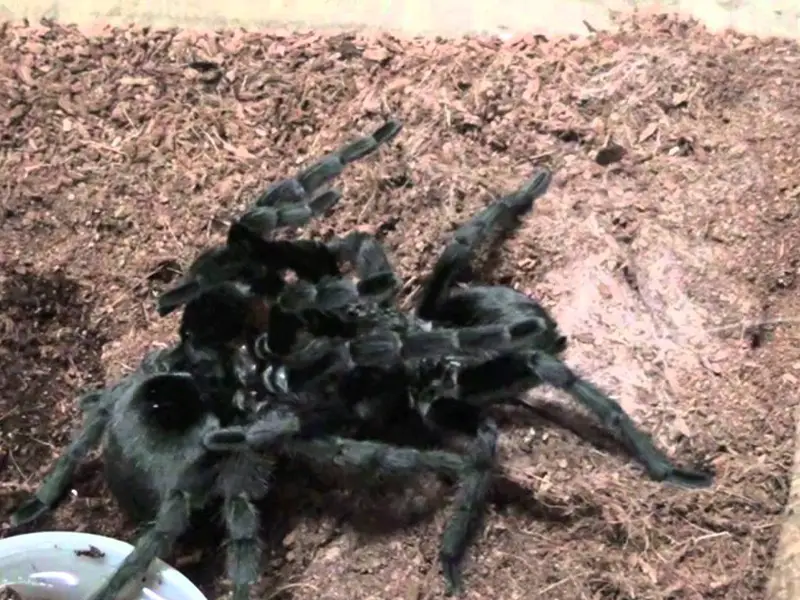
Breeding Brazilian black tarantulas can be difficult because females can become aggressive during copulation. You should only consider breeding two tarantulas once you’re educated on what to do in a failed breeding scenario.
To breed a pair of Brazilian black tarantulas, follow the instructions below:
- Place a healthy male and female spider in the same tank. The male will search for the female and invite her to mate.
- If the female shows signs of interest, the male will approach and try to fertilize the female. The male will hold back the female’s pincers and legs to prevent an attack. Remove the male immediately if the female makes sudden movements. An angry or disinterested female will try to eat the male.
- If the male is successful in fertilizing the female, remove the male from the tank before the female can attack.
- The fertilized female will lay up to 600 eggs. It will take up to three weeks of incubation for the eggs to hatch.
- Remove the female after two weeks to prevent the juvenile spiders from killing and eating her.
Choosing and Buying a Brazilian Black Tarantula
You can find Brazilian black spiders in pet stores. These spiders are also sold online by breeders.
Brazilian black tarantulas cost between $100 and $150 per spider, depending on the spider’s age and gender. Female spiders are more expensive because a female’s lifespan is more than double the length of a male’s. You’ll pay more for a grown spider because you won’t have to deal with the responsibility of raising a spider from young.
The Brazilian black tarantula is harder to find in America because this spider must be imported into the country. Importing a Brazilian black tarantula from its home country requires documentation. To avoid buying an illegally imported tarantula, ask your breeder to show their paperwork before you buy.
When buying a Brazilian black tarantula, make sure the spider is healthy. Signs of poor health include a shriveled abdomen, refusing food, lethargy, uncoordinated movements, and bald spots. An unhealthy tarantula will need costly immediate medical treatment. To avoid unnecessary spending, choose a tarantula that has had a proper upbringing from a reputable breeder.

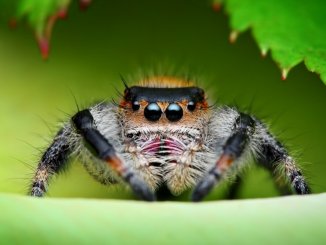
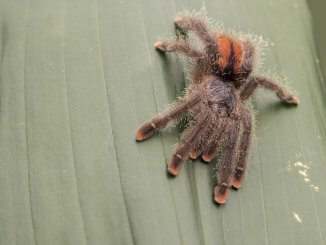
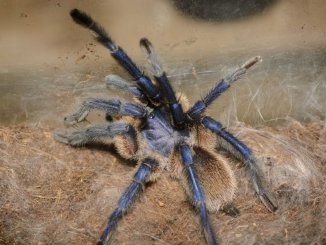

Hi there,
I have Brazlian Black and a Mexican Red knee .. I think they were born around about the same time, they are both spiderlings .. I think the Brazlian T has mouled, but he looks even smaller than he did before, plus the Mexican T almost twice as big as him .. I need your help please
Hi Barbie! Hopefully you’ll find these considerations useful: first of all, the Brazilian Black is huge but a very slow grower, it takes more than 5 years to reach maturity, so this could be the reason why it is smaller than the Mexican Red Knee. Also, growth is quite fast in the beginning, so being born even just a few days in advance can give the Mexican Red Knee quite a size advantage.
Secondly, sometimes just before molting, the spider may look bigger than what it is, because its previous skin has already started to detach, giving the wrong impression that the animal has shrunk after molding.